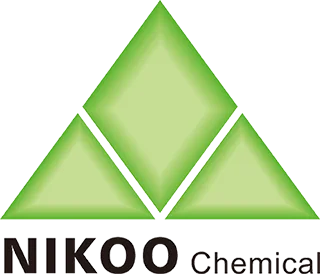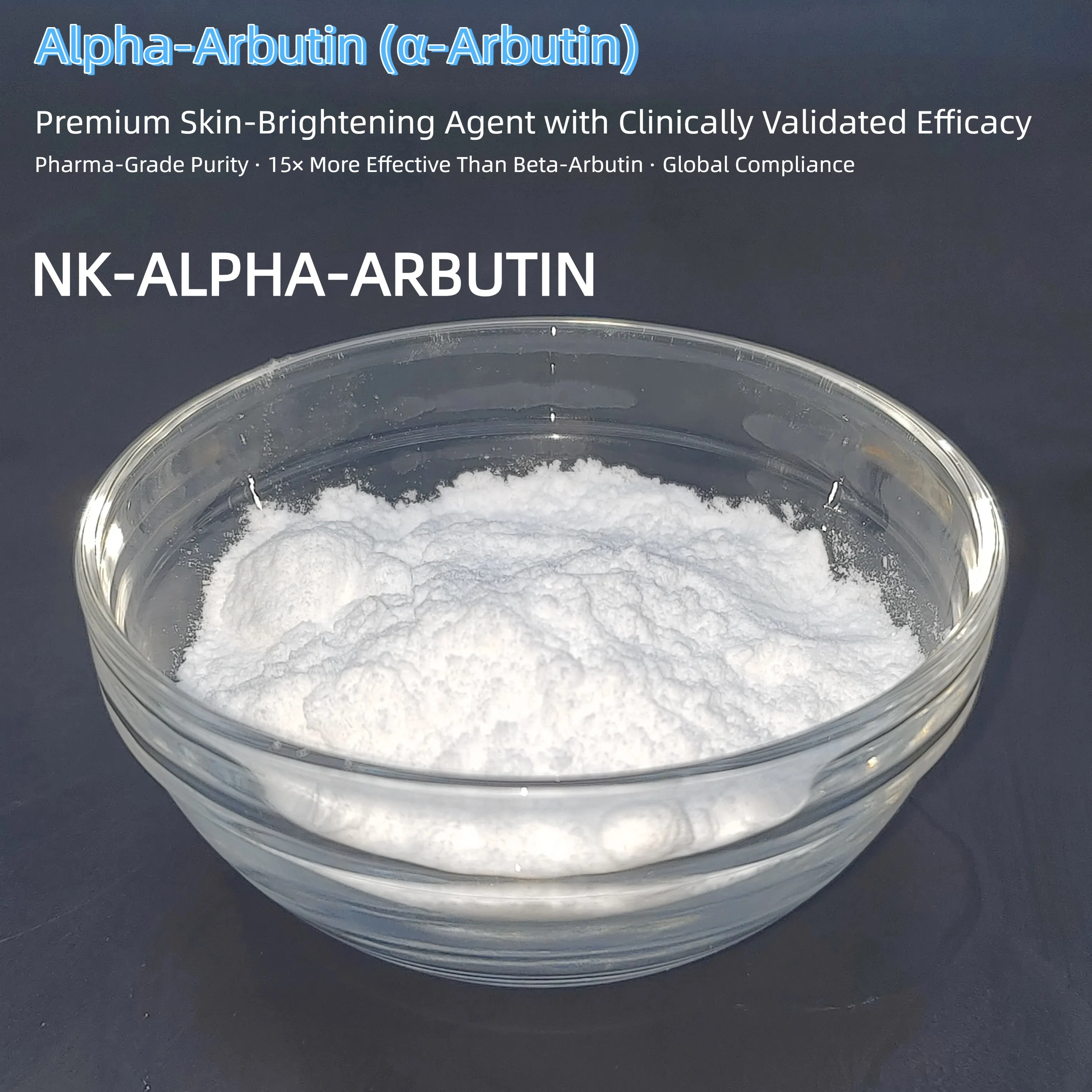ALPHA-ARBUTIN: Premium Skin-Brightening Agent with Clinically Validated Efficacy
Model No. : ALPHA-ARBUTIN
Brand Name: NIKOOCHEM
Place of Origin: Guangdong, China
Product Names: ALPHA-ARBUTIN
Other Names: alpha-Arbutin; 4-Hydrobenzoquinone-alpha-D-glucopyranoside
INCI: ALPHA-ARBUTIN
CAS: 84380-01-8
Molecular Formula: C₁₂H₁₆Oₐ
Molecular Weight: 272.25
Appearance: White crystalline powder
pH value : 5.0-7.0
Solubility : >100g/L in water (20°C)
Melting Point: 203.0-206±1℃
Specific Rotation: +174.0°~+186.0°
Heavy metal : <10PPM (Pb)
Loss on drying: ≤1.0%
Ignition residue: ≤0.5%
Hydroquinone: <10PPM
Total colony count: <1000cfu/g
Mold & yeast:<100cfu/g
Purity : ≧99%
Storage:25°C max, ≤60% RH (sealed)
MOQ : 25KG/Drum (sample available)
Packaging : 25KG/Drum
ALPHA-ARBUTIN: Premium Skin-Brightening Agent with Clinically Validated Efficacy
Pharma-Grade Purity · 15× More Effective Than Beta-Arbutin · Global Compliance
Product Overview
Alpha-Arbutin (CAS 84380-01-8) is a high-purity, single-α-configured tyrosinase inhibitor (≥98–99.5% HPLC) derived from enzymatic biosynthesis or sugarcane extraction. As a white crystalline powder with exceptional water solubility and thermal/light stability, it safely targets hyperpigmentation at the source—delivering 15× greater efficacy and persistence than beta-arbutin in cosmetic formulations
AC-α-Arbutin utilizes the latest enzyme technology, achieving a concentration exceeding 99.0% and boasting excellent solubility. It is used in cosmetics as a whitening agent, inhibiting the production and deposition of melanin.
Mechanism of Action and Efficacy
α-Arbutin's whitening mechanism is primarily through the inhibition of monophenolase activity, preventing tyrosinase from catalyzing the conversion of L-tyrosine to L-DOPA. α-Arbutin has a strong inhibitory effect on the monophenolase of tyrosinase, while also exhibiting a moderate activation effect on the diphenolase of tyrosinase. This mechanism of action demonstrates a mixed competitive and non-competitive activation. Numerous clinical studies have demonstrated α-Arbutin's unique effectiveness in promoting an even skin tone.
α-Arbutin significantly inhibits tyrosinase activity, reducing tyrosinase deposition in the skin, offering skin whitening, anti-discoloration, and anti-freckle benefits. At the same time, α-arbutin has a good synergistic effect with niacinamide, ascorbyl glucoside (AA2G), tranexamic acid derivatives and esculentol, and has excellent whitening, brightening and spot-removing effects.
Differences between α-Arbutin and β-Arbutin
1. Compared to β-Arbutin, α-Arbutin requires a smaller dosage, requiring only 1/5 to 1/4 of the β-Arbutin dosage. Furthermore, in general cosmetics, the dosage should be ≤5% to ensure safety. For over-the-counter (OTC) products and topical skin preparations for burns and scalds, the dosage should be ≤10%.
2. It is resistant to discoloration and degradation, exhibits no observed inhibition of cell growth, and exhibits no cytotoxicity.
3. It does not release any risk of hydroquinone (hydroquinone).
Core Applications & Benefits
Triple-Action Brightening
- Tyrosinase Inhibition: Competes with tyrosine for enzyme binding sites, blocking melanin synthesis without cytotoxicity .
- Anti-Inflammatory: Reduces UV-induced prostaglandin release and repairs post-blemish skin.
- Barrier Support: Enhances moisture retention and combats oxidative stress.
Superior Stability
Heat-resistant (up to 100°C) and pH-stable (3.0–9.0), ideal for serums, creams, and cleansers
Safety Profile
Non-irritating, non-comedogenic, and suitable for sensitive/acne-prone skin—zero hydroquinone detected (≤10 ppm)
Applications & Formulation Guidance
Cosmetics & Skincare
- Serums/Creams: 0.2–2.0% concentration reduces dark spots and evens tone .
- Synergistic Blends:
+ Niacinamide (5%): Boosts barrier repair and spot fading.
+ Tranexamic Acid: Targets stubborn PIH and melasma.
Pharmaceuticals
Topical Treatments: 0.5–5.0% in post-laser recovery gels and scar-healing ointments.
Functional Additives
Preservative Stabilizer: Extends shelf life in hyaluronic acid-based products
Applications
1. α-Arbutin is readily soluble in water, with a solubility of 151g/l at 20°C. It readily blends with other ingredients in formulations at temperatures below 70°C or at low to medium temperatures. Adjust the pH of the system to between 4.0 and 6.5, dissolve in water, and stir thoroughly. The system is stable and resists discoloration.
2. Recommended Dosage:
Water-based products: 0.2%-2.0%, Essence products: 0.2%-2.0%, Lotions, creams, and gels: 0.3-3.0%, Facial masks: 0.3-2.0%, BB creams and CC creams: 0.5-2.0%.
3. Adding niacinamide (0.5-1.0%) can enhance the synergistic effect. 4. When applying for a special cream for freckle removal and whitening, you can use α-arbutin combined with ascorbyl glucoside AA2G and niacinamide. The recommended usage is: α-arbutin: 1.0-2.0%, niacinamide: 0.5-1.0%, AA2G: 1-2%
Alpha-Arbutin's Skin Benefits
Alpha-Arbutin is a natural active ingredient extracted or synthesized from the bearberry plant. It primarily inhibits tyrosinase activity, reducing melanin production and thus achieving whitening and spot-lightening effects. Compared to β-arbutin, it is more stable and more permeable, and possesses antioxidant and anti-glycation properties, making it suitable for long-term use to improve uneven skin tone and dullness.
Specific Mechanism of Action
Inhibits melanin production.
By blocking the binding of tyrosinase to its substrate, it reduces melanin synthesis, prevents pigmentation, and improves conditions such as melasma and sun spots.
Compared to hydroquinone, alpha-Arbutin is milder, less irritating, and less likely to cause skin allergies.
Antioxidant and Anti-Glycation Effects
Scavenges free radicals, reduces oxidative damage caused by external stimuli such as UV rays, and delays skin aging.
Inhibits the formation of advanced glycation end products (AGEs), improving skin dullness and loss of elasticity caused by glycation.
Brightens skin tone and evens skin texture.
Long-term use can reduce existing dark spots, brighten overall skin tone, and create a radiant complexion.
It regulates epidermal metabolism, promotes stratum corneum renewal, and reduces localized pigmentation.
Storage & Handling
Conditions: 25°C max, ≤60% humidity, sealed/light-resistant containers
Safety: Non-irritating; use gloves/goggles during industrial handling

